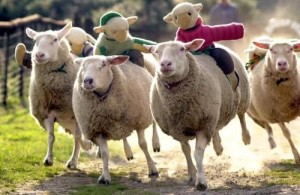The investigation of an outbreak of hemorrhagic uremic syndrome in Norway in 2006 indicated that the outbreak strain Escherichia coli O103:H25 could originate from sheep. A national survey of the Norwegian sheep population was performed, with the aim of identifying and describing a possible reservoir of potentially human-pathogenic E. coli O103, in particular of the H-types H2 and H25. The investigation of fecal samples from  585 sheep flocks resulted in 1222 E. coli O103 isolates that were analyzed for the presence of eae and stx genes, while a subset of 369 isolates was further examined for flagellar antigens (H-typing), stxsubtypes, bfpA and astA, and molecular typing by pulsed-field gel electrophoresis (PFGE).
585 sheep flocks resulted in 1222 E. coli O103 isolates that were analyzed for the presence of eae and stx genes, while a subset of 369 isolates was further examined for flagellar antigens (H-typing), stxsubtypes, bfpA and astA, and molecular typing by pulsed-field gel electrophoresis (PFGE).
The total ovine E. coli O103 serogroup was genetically diverse by number of H-types, virulotypes and PFGE banding patterns identified, although a tendency of clustering towards serotypes was seen. The flocks positive for potentially human-pathogenic E. coli O103 were geographically widely distributed and no association could be found to county or geographical region.
The survey showed that eae- stx- E. coli O103, probably non-pathogenic to humans, is very common in sheep with 27.5% positive flocks. Moreover, the study documented a low prevalence (0.7%) of potentially human-pathogenic Shiga toxin-producing E. coli O103:H2, while STEC O103:H25 was not detected. However, 3.1% and 5.8% of the flocks were positive for Enteropathogenic E. coliO103 belonging to H-type H2 and H25, respectively. These are of concern as potentially human pathogens by themselves, but more important as possible precursors for human-pathogenic STEC.
Camilla Sekse, Marianne Sunde, Petter Hopp, Torkjel Bruheim, Kofitsyo Sewornu Cudjoe, Bjorg Kvitle, Anne Margrete Urdahl
